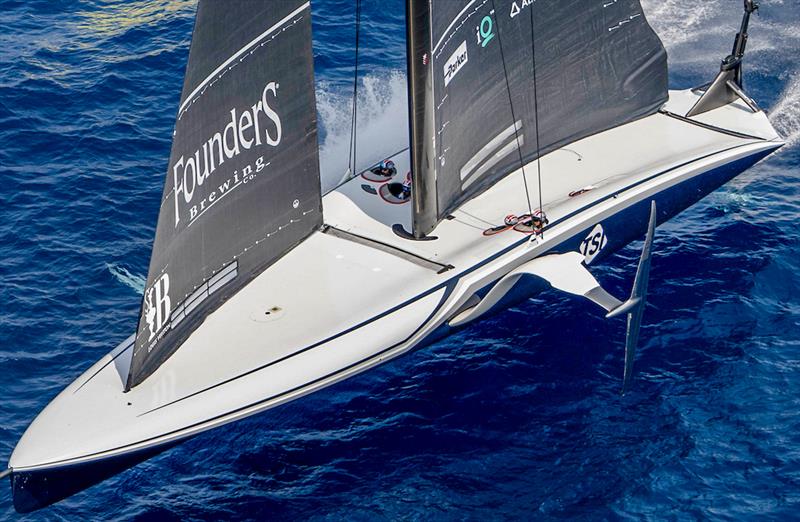
America's Cup: Covergate 2 - the Boffins reach for their Dictionaries
by Richard Gladwell Sail-World NZ 20 Aug 2024 07:01 PDT

American Magic - AC75 - Practice Session - Barcelona - August 19, 2024 © Ricardo Pinto / America's Cup
After considering the six-team submissions - well, really five submissions and one admission - the America's Cup Rules Committee, spent four pages of explanation and definition, before resolving to pass the question of the honeycomb cockpit fairings/covers to the Measurement Committee.
They requested the panel to "inspect the yacht [American Magic's AC75 raceboat] for compliance with the Class Rules."
The Measurement Committee will measure, investigate and report. As well there will be further submissions from the six teams, and only when those processes are complete can the Draft Interpretation be finalised.
That process will put some pressure on American Magic, as clearly they would like to have the matter resolved before they start racing for keeps in the Louis Vuitton Cup which begins in a week. Without the matter being put to bed before the start of the Challenger Selection Series the US team risk racing a boat which is found to not be in compliance with the Class Rules supplemented by the Technical Regulations.
Having a raceboat that complies with all the Rules, and remains in that state of compliance, is the responsibility of the team - and failing to be in compliance will usually result in disqualification from all races sailed while not in compliance, and a loss of points in the series.
So there is a serious twist behind the Rule Enquiry, and made more serious with the impeding deadline. It has taken a week to get where we are today in Rule Enquiry #242 - so the time pressure is on the US team - who have no option but to hurry up and wait.
But back to the rarefied air of the Rules Committee Room.
Only in the arcane world of the America's Cup could there be a Rule Enquiry on the Invisible. In this instance, the effect on the boundary layer of air as it passed over the honeycomb covers enclosing American Magic's four cyclors as they pedal frantically lying down in a "recumbent" position below decks in the US challenger.
The impressively credentialed Racing Rules Committee) instead of reaching for an impressive tome on the movement of an invisible air mass, the Committee picked up a copy of the Oxford English Dictionary. It proceeded to provide three pages of quotations from the definitive book regarding the meaning of various words used in the relevant Class Rules.
The mathematically challenged among us were disappointed that the three wise men turned down the opportunity to provide a worked example of the impressive formula prescribed in the Class Rules for calculating the thickness of the invisible boundary layer. Maybe that will wait for another time.
For all that, the Rules Committee was correct in their decision to hand the matter over to the Measurement Committee, whose role it is to inspect the various parts of the AC75 and make an appropriate report back to the Rules Committee for a further decision.
However, in the final Practice Session, aerial photographs revealed the real cause of other teams' concerns over the march that the US team had stolen.
With their upright cyclors, the other teams presented more parasitic drag. At the same time, those aboard American Magic were so well concealed as to be near invisible, and the back end of the US boat looked very clean aerodynamically.
While one team opined in the original Rule Enquiry that they, too, wished to fit similar covers, it was hard to see from the aerial shots where these could be used with the upright cyclors.
The perplexing part of the American Magic covers is why they are constructed in a honeycomb material—unless that is to have some cooling effect on the sweat pits that are the cyclors' abode, regardless of whether they are horizontal or vertical.
The Rules Committee decided that the honeycomb patterning was not an issue in itself, but it did spend some time looking at the definition of "finish."
"The Rules Committee considers that the cockpit fairings presented in this enquiry, whilst having a patterned shape, do not have a patterned or textured finish."
On the first page of their draft interpretation, the Rules Committee noted, "It is beyond the remit of the Rules Committee to determine in the case presented in this enquiry what is the primary purpose of these cockpit fairings."
They repeated that point in their final comment: "The Rules Committee does not know the team's primary purpose for this device. The Measurement Committee, per TR-5.3 and TR-5.4 shall inspect the yachts for compliance with the Class rules."
The full draft interpretation can be read by clicking here
Of course, the point remains - why use honeycomb covers? If a cover was made of a material and surface finish similar to the surrounding deck, there could be no argument as to legality.
No doubt the Measurement Committee will come up with an answer to that one, too.